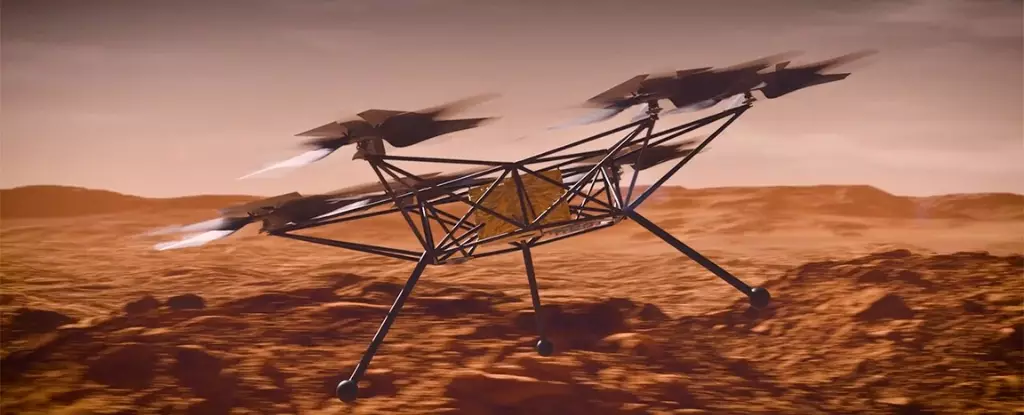In the quest to understand our neighboring planet Mars, NASA’s Ingenuity helicopter made history as the first aircraft to achieve powered flight on another celestial body in April 2021. This groundbreaking achievement not only demonstrated the feasibility of aerial reconnaissance in the thin Martian atmosphere but also paved the way for more advanced aerial vehicles to assist in planetary exploration. As humanity prepares for more ambitious missions to Mars, NASA has unveiled an innovative concept for its next aerial device: the Mars Chopper. This article delves into the significance of the Mars Chopper’s design, its potential applications, and the challenges that await.
A Historical Milestone: Ingenuity’s Achievements
Ingenuity, a compact helicopter resembling a drone, was ingeniously designed to operate within Mars’ less-than-ideal conditions, a testament to human innovation. It accompanied the Perseverance rover in its journey to Mars, serving primarily as a technology demonstrator. Its inaugural flight on April 19, 2021, saw it hover 10 feet above the Martian surface, marking a monumental achievement for aerospace engineering. Since that initial flight, Ingenuity has completed a remarkable 60 flights, providing valuable reconnaissance and gathering data vital for scientists planning future explorations.
Operating a drone on Mars is fraught with difficulties due to the atmosphere’s sparse composition, which has less than 1% of Earth’s density. This significant difference means that aerial vehicles must exert greater force to achieve lift—an engineering challenge that demands innovative rotor designs and robust materials. Additionally, the Martian terrain is notorious for fine dust that can damage machinery, necessitating careful design and construction to ensure durability. Ingenuity’s successful missions laid the groundwork for future aerial exploration and demonstrated that, even under challenging conditions, flight is possible.
Building on the successful framework established by Ingenuity, NASA has developed a concept for the Mars Chopper—a next-generation aerial reconnaissance vehicle. Unlike its predecessor, the Mars Chopper is designed with enhanced capabilities. Its larger size is comparable to that of an SUV, equipped with six rotors—each featuring smaller blades that collectively increase lift. This aerodynamic redesign demonstrates NASA’s commitment to leveraging the lessons learned from Ingenuity while adopting advanced propulsion techniques.
One of the most exciting aspects of the Mars Chopper is its increased payload capacity, which is expected to support a variety of scientific instruments. With an ability to carry up to 5 kilograms over distances of approximately 3 kilometers, this vehicle places significant emphasis on scientific inquiry. Such advancements suggest the Mars Chopper could assist in terrestrial analysis, scouting missions, and possibly even contribute to our understanding of Mars’ geology and atmosphere.
The design and engineering of the Mars Chopper is a collaborative effort involving NASA’s Jet Propulsion Laboratory and the Ames Research Center. This partnership signifies a strategic approach to tackle the various obstacles associated with Martian exploration. The ultimate goal is to create a vehicle that not only supports existing ground-based missions but also extends the reach of exploration into areas that rovers cannot easily access.
The Mars Chopper embodies a new frontier in aerial exploration. Its potential capabilities extend beyond mere reconnaissance; it could also play a crucial role in paving the way for future manned missions. The ability to scout terrain ahead of human exploration ensures safety and allows for a more informed approach to navigating the Martian landscape.
As humanity stands on the precipice of deeper exploration into our solar system, the Mars Chopper represents more than just a vehicle; it symbolizes hope and curiosity about what lies beyond Earth. By improving the efficiency and safety of aerial reconnaissance, we can significantly enhance the scientific value of both surface operations and future human missions to Mars.
The Mars Chopper not only draws inspiration from the pioneering achievements of Ingenuity but also embodies a leap forward in our ability to explore alien worlds. As NASA continues to develop this innovative technology, it opens new avenues for scientific discovery and potentially even human habitation beyond our planet. The future of Mars exploration looks promising, and the Mars Chopper may very well be at the forefront of that journey.


Leave a Reply